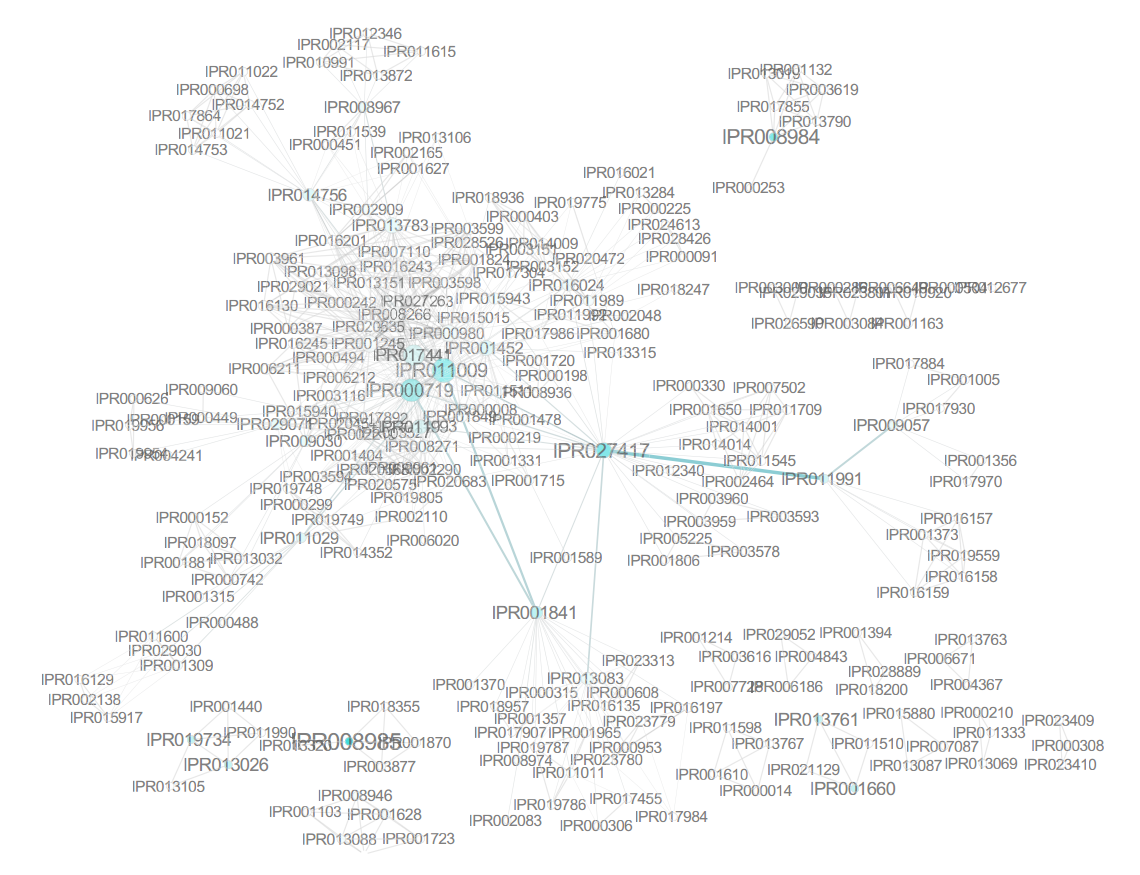Difference between revisions of "File:Fig5 Naulaerts BioAndBioInsights2016 10.png"
Shawndouglas (talk | contribs) (Added summary.) |
Shawndouglas (talk | contribs) m (→Summary: Text) |
||
| Line 1: | Line 1: | ||
==Summary== | ==Summary== | ||
{{Information | {{Information | ||
|Description='''Figure 5.''' Frequent itemsets were mapped to a Cytoscape network that displays which domains are often found to be associated in interacting proteins. The width of the edges indicates the betweenness centrality, while the node size is representative of the degree of the node. Central in this network seem to be IPR001452 (SH3 domain), IPR013783 (immunoglobulin-like fold), and IPR027417 (P-loop NTPase), which is the most prevalent domain in nucleotide-binding proteins. However, the items IPR011009 and IPR000719 were present in the highest number of distinct itemsets. These terms refer to the protein kinase-like domain and the protein kinase domain, respectively, and their importance supports the observations made in Figure 4 that indicate kinase interactions form a vast part of the human interactome. It is interesting to note that of the 1753 proteins featuring a WD40/YVTN repeat- | |Description='''Figure 5.''' Frequent itemsets were mapped to a Cytoscape network that displays which domains are often found to be associated in interacting proteins. The width of the edges indicates the betweenness centrality, while the node size is representative of the degree of the node. Central in this network seem to be IPR001452 (SH3 domain), IPR013783 (immunoglobulin-like fold), and IPR027417 (P-loop NTPase), which is the most prevalent domain in nucleotide-binding proteins. However, the items IPR011009 and IPR000719 were present in the highest number of distinct itemsets. These terms refer to the protein kinase-like domain and the protein kinase domain, respectively, and their importance supports the observations made in Figure 4 that indicate kinase interactions form a vast part of the human interactome. It is interesting to note that of the 1753 proteins featuring a WD40/YVTN repeat-like-containing domain (IPR015943) in human beings, only associations with the kinase domain (IPR000719) and the kinase-like domain (IPR011009) were retained. The concanavalin A-like lectin/glucanases superfamily (IPR008985) is also shown to have a relatively high centrality in this network. | ||
|Source={{cite journal |title=Practical approaches for mining frequent patterns in molecular datasets |journal=Bioinformatics and Biology Insights |author=Naulaerts, S.; Moens, S.; Engelen, K.; Vanden Berghe, W.; Goethals, B.; Laukens, K.; Meysman, P. |volume=10 |pages=37–47 |year=2016 |doi=10.4137/BBI.S38419 |pmid=27168722 |pmc=PMC4856181}} | |Source={{cite journal |title=Practical approaches for mining frequent patterns in molecular datasets |journal=Bioinformatics and Biology Insights |author=Naulaerts, S.; Moens, S.; Engelen, K.; Vanden Berghe, W.; Goethals, B.; Laukens, K.; Meysman, P. |volume=10 |pages=37–47 |year=2016 |doi=10.4137/BBI.S38419 |pmid=27168722 |pmc=PMC4856181}} | ||
|Author=Naulaerts, S.; Moens, S.; Engelen, K.; Vanden Berghe, W.; Goethals, B.; Laukens, K.; Meysman, P. | |Author=Naulaerts, S.; Moens, S.; Engelen, K.; Vanden Berghe, W.; Goethals, B.; Laukens, K.; Meysman, P. | ||
Latest revision as of 18:57, 24 August 2016
Summary
| Description |
Figure 5. Frequent itemsets were mapped to a Cytoscape network that displays which domains are often found to be associated in interacting proteins. The width of the edges indicates the betweenness centrality, while the node size is representative of the degree of the node. Central in this network seem to be IPR001452 (SH3 domain), IPR013783 (immunoglobulin-like fold), and IPR027417 (P-loop NTPase), which is the most prevalent domain in nucleotide-binding proteins. However, the items IPR011009 and IPR000719 were present in the highest number of distinct itemsets. These terms refer to the protein kinase-like domain and the protein kinase domain, respectively, and their importance supports the observations made in Figure 4 that indicate kinase interactions form a vast part of the human interactome. It is interesting to note that of the 1753 proteins featuring a WD40/YVTN repeat-like-containing domain (IPR015943) in human beings, only associations with the kinase domain (IPR000719) and the kinase-like domain (IPR011009) were retained. The concanavalin A-like lectin/glucanases superfamily (IPR008985) is also shown to have a relatively high centrality in this network. |
|---|---|
| Source |
Naulaerts, S.; Moens, S.; Engelen, K.; Vanden Berghe, W.; Goethals, B.; Laukens, K.; Meysman, P. (2016). "Practical approaches for mining frequent patterns in molecular datasets". Bioinformatics and Biology Insights 10: 37–47. doi:10.4137/BBI.S38419. PMC PMC4856181. PMID 27168722. https://www.ncbi.nlm.nih.gov/pmc/articles/PMC4856181. |
| Date |
2016 |
| Author |
Naulaerts, S.; Moens, S.; Engelen, K.; Vanden Berghe, W.; Goethals, B.; Laukens, K.; Meysman, P. |
| Permission (Reusing this file) |
|
| Other versions |
Licensing
|
|
This work is licensed under the Creative Commons Attribution 3.0 Unported License. |
File history
Click on a date/time to view the file as it appeared at that time.
| Date/Time | Thumbnail | Dimensions | User | Comment | |
|---|---|---|---|---|---|
| current | 18:53, 24 August 2016 |  | 1,140 × 875 (499 KB) | Shawndouglas (talk | contribs) |
You cannot overwrite this file.
File usage
The following page uses this file:









